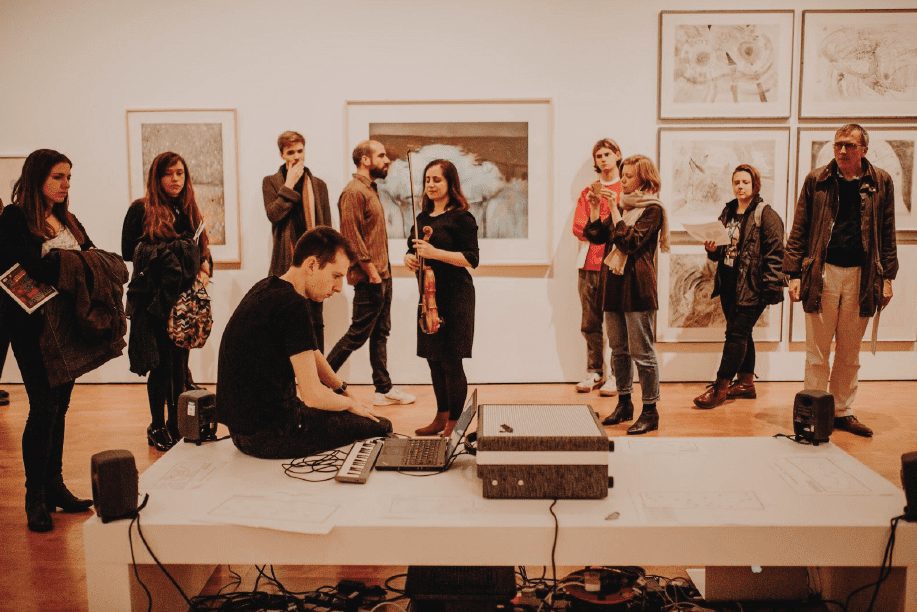On 31 October 2019, composer, researcher and performer Jonathan Packham invited gallery visitors to ‘play’ the architecture of the Piper Gallery. In this post, Jonathan tells the story of this ambitious project and reveals what visitors can expect at the second performance taking place on the evening of Thursday 21 November – a must see.
Copper House Music is a new composition commissioned by Modern Art Oxford in response to the architectural plans of the John Piper Gallery. It received its first performance on the 31 October 2019 as part of EMPRES’ Art of Noises IV event, and will be performed again at the MAO Social on 21 November 2019.
To my mind, the Piper is extremely adaptable. Each artist that exhibits brings their own energy to the room—every time I see new work in there, the space feels totally transformed somehow. However, before it was this chameleonic gallery space, it was the Copper House of the City Brewery, home to large metal vessels (“coppers”) in which wort and hops were boiled. The title is a nod to the history of the room, acknowledging the many ways that the Piper space has been purposed and repurposed even prior to its artistic function. This adaptability was my starting point. How could I compose a piece that engaged directly with the architectural structure of the Piper Gallery space, whilst allowing performers and listeners to bring their own perspectives and energies into the room?

Copper House Music is experienced and activated through playing instruments, singing, or listening. Each of these employs a user-created score as a guide for action. Each participant in the piece is given a “base sheet” (see below), which shows an empty void in the shape of the Piper Gallery. Each user then affixes paper fragments of their choosing onto the space, allowing them to participate in a performance of the piece.

There are fragments that indicate long pitches to sing or play; lines that suggest paths for movement around the gallery; and shapes that describe strategies for “scored listening”. Those detailing fragments to play are based on the space frame nodes in the ceiling of the gallery, whilst the pitches I use for sung fragments were produced using ratios based on the spatial proportions of the Piper. The fragments for listening were inspired by a top-down map of the area surrounding Modern Art Oxford (see below, left), transforming habitual urban paths into strategies for focused listening (see below, right).

Accordingly, both performers and listeners can create a bespoke score that prescribes their personal sonic and choreographic action in the space, simply by filling their ‘base sheet’ (see below) with paper fragments. At the premiere on 31 October, willing participants were invited to make their own listening scores in Modern Art Oxford’s café space, before moving up to the Piper Gallery in their own time to hear the installed performers and singers, who had already produced their own scores for performance.

My aim for Copper House Music is twofold. Firstly, I seek to engage directly with the architectural identity of the Piper Gallery by demonstrating a more meaningful relationship between the two-dimensional, geometric space of the score and the sensorial space of performance.
Secondly, I want to illustrate that static geometric representation cannot account for the totality of our spatial experience. In Copper House Music, a listener’s sense of the space is affected by their individual actions as well as those of their fellow participants. These actions are prescribed through the process of personal score creation. Accordingly, the static geometric architecture of the “base sheet” is subjected to and transformed by each participant’s dynamic presence. Processes of listening, sensing, and socialising are central to the way we establish our presence in the room—and the score acts as a platform for encouraging these activities.

Ultimately, Copper House Music is a participatory piece. As architect Lawrence Halpin writes: “it is through [scores] that we can involve ourselves creatively in ‘doing’… the score is the mechanism that allows us all to become involved, to make our presence felt”. I hope too that people felt present and connected in the warm, meditative atmosphere of the gallery on that chilly Thursday evening, and were able to bring home their own score as a personal reminder of that presence.
There is another opportunity to experience Copper House Music on the 21 November 2019 as part of the MAO Social.
Words by Jonathan Packham (www.jonathanpackham.org/)
Photography by Helen Messenger (www.helenmessengerphotography.com/)
